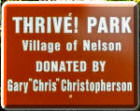 |
 |
| Why Visit? |
| Thrive! Park Map(s) |
| Thrive! Park Trails |
| Thrive! Park Photos |
| Thrive! Park Bluff Prairie Restoration |
| Village of Nelson Website |
| Thrive! Efforts Adjacent to Thrive! Park |
| The Thrive! Center |
| GChris Sculpture Studio/Gallery |
 |
 |
| Why Visit? |
| Thrive! Park Map(s) |
| Thrive! Park Trails |
| Thrive! Park Photos |
| Thrive! Park Bluff Prairie Restoration |
| Village of Nelson Website |
| Thrive! Efforts Adjacent to Thrive! Park |
| The Thrive! Center |
| GChris Sculpture Studio/Gallery |
| Thrive! Park - Why Visit? | |
 |
|
| Article on Thrive! Park by Buffalo County News | |
| Article on Thrive! Park by Bank of Alma | |
|
Thrive! Park is a great place to enjoy
nature! Much of the park is covered by a diverse oak woodland which
is home to many critters and spring wildflowers. With hiking trails
already established, walking uphill is made easier. The upper side
of the bluff is a If you grew up near the Mississippi River, you saw goat prairies and just did not know it. And no, you would not have seen goats. The common name for these dry bluff prairies is based on the steepness of these prairies implying only goats could reach them. It also meant plows and cattle could not plow or pasture those areas. Before settlement the prairies often burned from lightening strikes. Because fires were threats to communities, fires were suppressed. Without fire, red cedar trees tended to seed in and shade out the prairies beneath. Current restoration efforts remove the red cedar and other trees to once again allow the seed in the bluff soils to rejuvenate the original vegetation - prairie. Prairies once covered millions pf acres from Ohio to California and from Canada to Mexico. Less than 1% remains due to plowing, draining and development following settlement. Wisconsin once contained 2.1 million acres of prairie. Less than 10,000 acres still exist. So these bluff prairies in the driftless area of Western Wisconsin are prized and protected. You will find native wildflowers in late spring, summer and fall seasons. These sun-loving flowers are the natural habitat of many of our pollinators. The loss of pollinator habitat alone makes these goat prairies precious. Dry prairies that are found on southwest facing bluffs provide habitat to many birds, small mammals and reptiles, many of which are also becoming rare. Thrive! Park will provide food and shelter for them naturally. No inventory of the flora and fauna of this new parkland has yet been taken. It will be interesting to learn how diverse and important these 25 acres might be. As we learn more, we will let visitors know what to look for beyond expansive views. |
  |
|
View of Thrive! Park from Mississippi River Valley |
|
#Thrive #ThrivingFuture #ThriveEndeavor #AllThriveForever #T! #Thrive!
Thrive!
Park

Thrive! - All Thrive Forever
